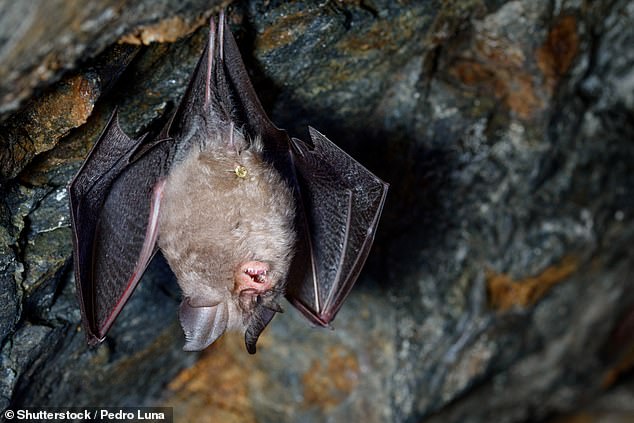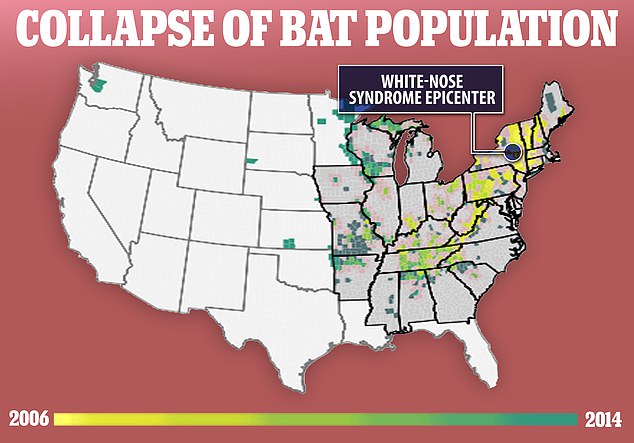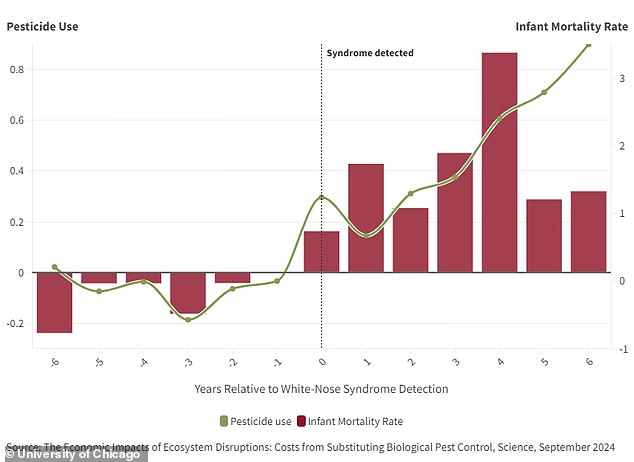How the Collapse of an Unlikely Animal Population Could Cost the Lives of Thousands of American CHILDREN
A new study finds that the collapse of the animal population in the US is linked to the deaths of thousands of children.
Millions of bats are dying in agricultural areas across the country due to a deadly fungus that emerged in 2006.
Farmers have long relied on the winged creatures as natural pesticides, as they eat at least 40 percent of their body weight in insects every night, but workers forced to spray more toxic chemicals to compensate for the loss.
Pesticides are associated with an increased risk of birth defects, low birth weight, and fetal death.
More than 1,000 babies have died since farmers increased pesticide use in response to declining bat populations
The new analysis finds that between 2006 and 2017, increases in toxic chemicals killed 1,334 babies in 1,185 counties across 27 states, the majority on the East Coast.
The IAn invasive fungus called Pseudogymnoascus destructans causes a disease called white-nose syndrome (WNS), which has killed 6.7 million bats in the past 18 years.
Bats are known to eat insects that can be as much as 40 percent of their body weight per day, many of which are pests to agriculture.
However, the analysis found that the deaths have led to farmers in the affected regions having to use 31 percent more pesticides each year.
This corresponded to a eight percent increase in infant mortality rate due to pesticides.
According to the study, infant mortality rose by 0.25 percent for every one percent increase in pesticides.
The hardest hit counties are mainly in the eastern and southern regions of the US, with New York, Michigan, Louisiana and Maine in particular experiencing declining bat populations.
Eyal Frank, study author and assistant professor at the University of Chicago, analyzed county-level data on detections of white-nose syndrome in bats, pesticide use by farmers, and other health indicators, including infant mortality.
When farmers spray pesticides on their crops, wind and water can carry them away from the original location, exposing other residents of the area outside their farm, according to the study published in the journal Science.
Higher levels of agrochemical pollution are observed during the peak of the farming season, from April to September.
Pesticides are associated with negative health effects, including increased risk of chronic diseases such as cancer, neurological disorders and developmental delays. They can also cause acute poisoning.

About 6.7 million bats have died from infection with an invasive fungus that causes white-nose syndrome

White-nose syndrome causes dehydration, starvation and death in bats. It comes from a fungus that was found in New York in 2006 and has since spread to 38 states in the US.

Every time farmers increased their pesticide use by one percent, the infant mortality rate increased by 0.25 percent
According to Frank, increased use of pesticides by farmers is associated with higher domestic infant mortality, not including deaths from accidents or homicides.
“Bats have gotten a bad reputation as something to be afraid of, especially after reports of a possible link to the origins of Covid-19,” Frank said.
“But bats do make a valuable contribution to society, because they are a natural pesticide. And this study shows that their decline can be harmful to humans.”
The fungus can spread through infected bats, but can also be transmitted from cave to cave on human clothing and equipment.
The bacteria can grow on the ears, nose and wings of bats and can invade deeper skin tissue, causing WNS, which leads to dehydration, starvation and death.
Pseudogymnoascus destructans is native to Europe and Asia, where it does not seem to bother bats. However, it is believed that the species was first introduced to New York State by a tourist in 2006.
It was found in a cave connected to a commercial cave that receives 200,000 visitors annually.
Since the fungus was discovered, it has spread rapidly at a rate of 200 miles per year, affecting a total of 38 states so far, the Centers for Biological Diversity.
The plant grows best in damp caves where bats typically hibernate and thrives in cool temperatures around 14 degrees Celsius.
There are 13 confirmed bat species infected with WNS, including the brown long-eared bat, the little brown bat, and the tricolored bat.
The northern long-eared bat has been hit hardest by the disease, with populations declining by as much as 99 percent in several eastern U.S. states.
